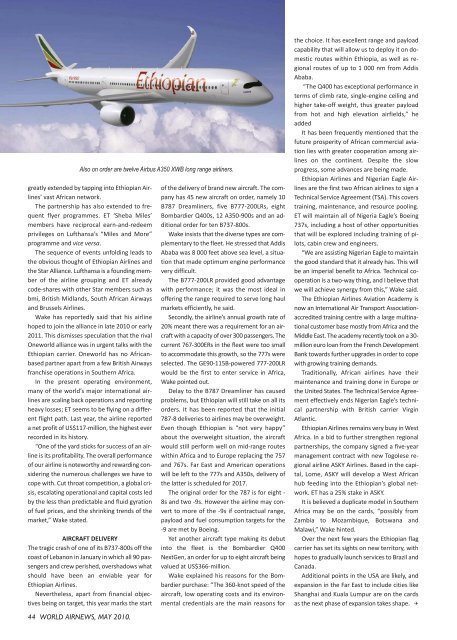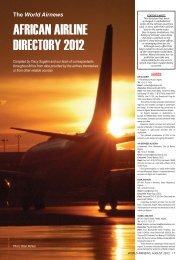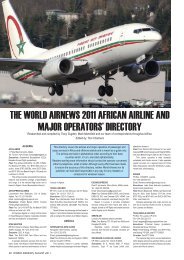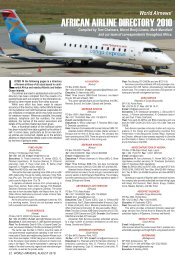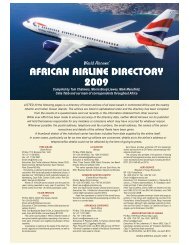May 2010 covers_Covers.qxd - World Airnews
May 2010 covers_Covers.qxd - World Airnews
May 2010 covers_Covers.qxd - World Airnews
Create successful ePaper yourself
Turn your PDF publications into a flip-book with our unique Google optimized e-Paper software.
Also on order are twelve Airbus A350 XWB long range airliners.<br />
greatly extended by tapping into Ethiopian Airlines’<br />
vast African network.<br />
The partnership has also extended to frequent<br />
flyer programmes. ET ‘Sheba Miles’<br />
members have reciprocal earn-and-redeem<br />
privileges on Lufthansa’s “Miles and More”<br />
programme and vice versa.<br />
The sequence of events unfolding leads to<br />
the obvious thought of Ethiopian Airlines and<br />
the Star Alliance. Lufthansa is a founding member<br />
of the airline grouping and ET already<br />
code-shares with other Star members such as<br />
bmi, British Midlands, South African Airways<br />
and Brussels Airlines.<br />
Wake has reportedly said that his airline<br />
hoped to join the alliance in late <strong>2010</strong> or early<br />
2011. This dismisses speculation that the rival<br />
Oneworld alliance was in urgent talks with the<br />
Ethiopian carrier. Oneworld has no Africanbased<br />
partner apart from a few British Airways<br />
franchise operations in Southern Africa.<br />
In the present operating environment,<br />
many of the world’s major international airlines<br />
are scaling back operations and reporting<br />
heavy losses; ET seems to be flying on a different<br />
flight path. Last year, the airline reported<br />
a net profit of US$117-million, the highest ever<br />
recorded in its history.<br />
“One of the yard sticks for success of an airline<br />
is its profitability. The overall performance<br />
of our airline is noteworthy and rewarding considering<br />
the numerous challenges we have to<br />
cope with. Cut throat competition, a global crisis,<br />
escalating operational and capital costs led<br />
by the less than predictable and fluid gyration<br />
of fuel prices, and the shrinking trends of the<br />
market,” Wake stated.<br />
AIRCRAFT DELIVERY<br />
The tragic crash of one of its B737-800s off the<br />
coast of Lebanon in January in which all 90 passengers<br />
and crew perished, overshadows what<br />
should have been an enviable year for<br />
Ethiopian Airlines.<br />
Nevertheless, apart from financial objectives<br />
being on target, this year marks the start<br />
44 WORLD AIRNEWS, MAY <strong>2010</strong>.<br />
of the delivery of brand new aircraft. The company<br />
has 45 new aircraft on order, namely 10<br />
B787 Dreamliners, five B777-200LRs, eight<br />
Bombardier Q400s, 12 A350-900s and an additional<br />
order for ten B737-800s.<br />
Wake insists that the diverse types are complementary<br />
to the fleet. He stressed that Addis<br />
Ababa was 8 000 feet above sea level, a situation<br />
that made optimum engine performance<br />
very difficult.<br />
The B777-200LR provided good advantage<br />
with performance; it was the most ideal in<br />
offering the range required to serve long haul<br />
markets efficiently, he said.<br />
Secondly, the airline’s annual growth rate of<br />
20% meant there was a requirement for an aircraft<br />
with a capacity of over 300 passengers. The<br />
current 767-300ERs in the fleet were too small<br />
to accommodate this growth, so the 777s were<br />
selected. The GE90-115B-powered 777-200LR<br />
would be the first to enter service in Africa,<br />
Wake pointed out.<br />
Delay to the B787 Dreamliner has caused<br />
problems, but Ethiopian will still take on all its<br />
orders. It has been reported that the initial<br />
787-8 deliveries to airlines may be overweight.<br />
Even though Ethiopian is “not very happy”<br />
about the overweight situation, the aircraft<br />
would still perform well on mid-range routes<br />
within Africa and to Europe replacing the 757<br />
and 767s. Far East and American operations<br />
will be left to the 777s and A350s, delivery of<br />
the latter is scheduled for 2017.<br />
The original order for the 787 is for eight -<br />
8s and two -9s. However the airline may convert<br />
to more of the -9s if contractual range,<br />
payload and fuel consumption targets for the<br />
-9 are met by Boeing.<br />
Yet another aircraft type making its debut<br />
into the fleet is the Bombardier Q400<br />
NextGen, an order for up to eight aircraft being<br />
valued at US$366-million.<br />
Wake explained his reasons for the Bombardier<br />
purchase: “The 360-knot speed of the<br />
aircraft, low operating costs and its environmental<br />
credentials are the main reasons for<br />
the choice. It has excellent range and payload<br />
capability that will allow us to deploy it on domestic<br />
routes within Ethiopia, as well as regional<br />
routes of up to 1 000 nm from Addis<br />
Ababa.<br />
“The Q400 has exceptional performance in<br />
terms of climb rate, single-engine ceiling and<br />
higher take-off weight, thus greater payload<br />
from hot and high elevation airfields,” he<br />
added<br />
It has been frequently mentioned that the<br />
future prosperity of African commercial aviation<br />
lies with greater cooperation among airlines<br />
on the continent. Despite the slow<br />
progress, some advances are being made.<br />
Ethiopian Airlines and Nigerian Eagle Airlines<br />
are the first two African airlines to sign a<br />
Technical Service Agreement (TSA). This <strong>covers</strong><br />
training, maintenance, and resource pooling.<br />
ET will maintain all of Nigeria Eagle’s Boeing<br />
737s, including a host of other opportunities<br />
that will be explored including training of pilots,<br />
cabin crew and engineers.<br />
“We are assisting Nigerian Eagle to maintain<br />
the good standard that it already has. This will<br />
be an imperial benefit to Africa. Technical cooperation<br />
is a two-way thing, and I believe that<br />
we will achieve synergy from this,” Wake said.<br />
The Ethiopian Airlines Aviation Academy is<br />
now an International Air Transport Associationaccredited<br />
training centre with a large multinational<br />
customer base mostly from Africa and the<br />
Middle East. The academy recently took on a 30million<br />
euro loan from the French Development<br />
Bank towards further upgrades in order to cope<br />
with growing training demands.<br />
Traditionally, African airlines have their<br />
maintenance and training done in Europe or<br />
the United States. The Technical Service Agreement<br />
effectively ends Nigerian Eagle’s technical<br />
partnership with British carrier Virgin<br />
Atlantic.<br />
Ethiopian Airlines remains very busy in West<br />
Africa. In a bid to further strengthen regional<br />
partnerships, the company signed a five-year<br />
management contract with new Togolese regional<br />
airline ASKY Airlines. Based in the capital,<br />
Lome, ASKY will develop a West African<br />
hub feeding into the Ethiopian’s global network.<br />
ET has a 25% stake in ASKY.<br />
It is believed a duplicate model in Southern<br />
Africa may be on the cards, “possibly from<br />
Zambia to Mozambique, Botswana and<br />
Malawi,” Wake hinted.<br />
Over the next few years the Ethiopian flag<br />
carrier has set its sights on new territory, with<br />
hopes to gradually launch services to Brazil and<br />
Canada.<br />
Additional points in the USA are likely, and<br />
expansion in the Far East to include cities like<br />
Shanghai and Kuala Lumpur are on the cards<br />
as the next phase of expansion takes shape. Q


